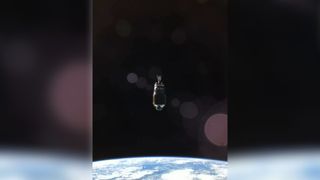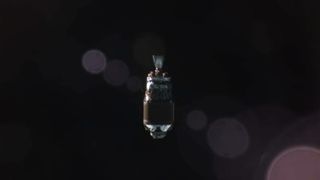
The discarded upper stage of a Japanese H-2A rocket, as photographed by the ADRAS-J spacecraft in June 2024.
(Image credit: Astroscale)
Astroscale Japan has released yet more eye-watering imagery of space debris in Earth orbit.
The Tokyo-based company launched its Active Debris Removal spacecraft (ADRAS-J) atop a Rocket Lab Electron rocket on Feb. 18, 2024. ADRAS-J is designed to test safe methods of approaching and surveying space debris in orbit through what are known as Rendezvous and Proximity Operations, or RPO.
To test the spacecraft’s capabilities, Astroscale sent ADRAS-J to photograph the discarded upper stage of a Japanese H-2A rocket that was launched in 2009. The company released a statement on July 9 showing off a new image of the debris as it floats lifeless above a blue-and-white Earth with the sun’s glare reflecting off of it.
ADRAS-J took the photograph sometime in June 2024 while just 165 feet (50 meters) away from the bus-sized H-2A upper stage, which measures some 36 feet (11 m) in length and weighs 3 tons.
Aside from taking photographs of the space debris, ADRAS-J used the RPO with the defunct upper stage to demonstrate its collision avoidance system, which includes autonomous operations. In fact, while making the close approach to the rocket body, Astroscale’s spacecraft initiated an autonomous abort when it experienced an attitude (orientation) anomaly.
ADRAS-J was then able to maneuver away from the debris, a capability that demonstrates the spacecraft “can maintain safety even while performing close approach observations of non-cooperative objects,” Astroscale wrote in the statement.
Remote proximity operations such as these are delicate maneuvers, due to the fact that many space debris objects such as the H-2A’s upper stage are not designed with such missions in mind.
Breaking space news, the latest updates on rocket launches, skywatching events and more!

A close-up of a discarded bus-sized upper stage of a Japanese H-2A rocket photographed by Astroscale’s Active Debris Removal spacecraft (ADRAS-J) in June 2024. (Image credit: Astroscale)
Astroscale has high hopes for ADRAS-J. When this phase of the mission, known as Commercial Removal of Debris Demonstration (CRD2), comes to a close, the company plans to move ahead with a new phase funded by the Japan Aerospace Exploration Agency (JAXA) in which it plans to remove and deorbit a large piece of “non-cooperative” space junk — that is, one that was not designed with such a deorbiting mission in mind.
“This next phase holds significance in addressing the space debris issue and laying the foundation for a sustainable environment for future generations,” Eddie Kato, the president of Astroscale Japan, said in a previous statement.
Phase 2 of the CRD2 mission is scheduled to begin no earlier than 2026.
Join our Space Forums to keep talking space on the latest missions, night sky and more! And if you have a news tip, correction or comment, let us know at: [email protected].
Brett is curious about emerging aerospace technologies, alternative launch concepts, military space developments and uncrewed aircraft systems. Brett’s work has appeared on Scientific American, The War Zone, Popular Science, the History Channel, Science Discovery and more. Brett has English degrees from Clemson University and the University of North Carolina at Charlotte. In his free time, Brett enjoys skywatching throughout the dark skies of the Appalachian mountains.
>>> Read full article>>>
Copyright for syndicated content belongs to the linked Source : Space.com – https://www.space.com/astrobotic-space-junk-probe-rocket-photo













![[News] Japan Develops 10nm Nanoimprint Technology, with Potential to Tackle EUV Bottleneck – TrendForce](https://earth-news.info/wp-content/uploads/2025/12/329851-news-japan-develops-10nm-nanoimprint-technology-with-potential-to-tackle-euv-bottleneck-trendforce-360x180.jpg)









![[News] Japan Develops 10nm Nanoimprint Technology, with Potential to Tackle EUV Bottleneck – TrendForce](https://earth-news.info/wp-content/uploads/2025/12/329851-news-japan-develops-10nm-nanoimprint-technology-with-potential-to-tackle-euv-bottleneck-trendforce-120x86.jpg)






